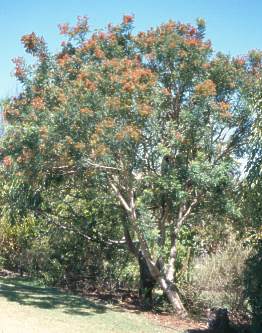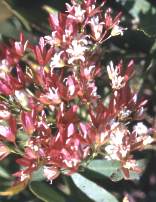Loxostylis alata
Loxostylis alata A.Spreng. ex Rchb.
Family: Anacardiaceae
Common names: Wild Pepper Tree, Tarwood, Tigerwood (Eng.), Wildepeperboom, Breekhout, Tederhout, Teerhout, Tierhout (Afr.), Isibara (Zulu), Isibara (Xhosa)
SA Tree No: 365
Introduction
A small, well-shaped tree with glossy foliage tinged with red when young and masses of white flowers in early summer, and if the tree is a female it has showy pinkish red fruits.

Description
Description
Tarwoods are evergreen, ornamental trees which will grow in a wide range of ecological habitats. This tree closely resembles the Brazilian pepper tree, Schinus terebinthifolius of the same family, which does not have the characteristic red sepals.
The leaves are alternate and compound with 2 to 5 pairs of leaflets,including a terminal leaflet. Typical of the species is the conspicuous winged rachis (midrib). Young leaves are red. The bark is grey, with vertical fissures and shows bright red if injured.
The flowers are male or female, on different trees and produced in early to mid summer, from November to February. The male flowers are white and pleasantly scented and the female flowers are greenish white.

The petals of the female flowers fall soon, but their sepals enlarge substantially and turn pink-red, coveringthe developing fruit and creating a very attractive display.

Distribution and habitat
Distribution description
The genus Loxostylis contains a single species that only occurs in the Eastern Cape and KwaZulu-Natal, where it is found along forest margins, beside rivers and on outcrops of quartz and sandstone.
Derivation of name and historical aspects
History
The name Loxostylis is derived from the Greek loxos meaning'crooked' or 'oblique', and the Latin stylis for style, a referenceto the lateral attachment of the style to the ovary. The specific name is based on the Latin alatus meaning 'winged', referring to the winged rachis of the leaf.
The common name tarwood presumably refers to the oily residue from the fruits, which was possibly used as or compared to the wagon grease of the pioneers of the past. The name tierhout is a mystery and probably due to a spelling mistake. Some writers suggest it may refer to the strength of the wood, but it is not particularly strong. The other suggestion is that leopards (sometimes callled tiere in Afrikaans) liked to sharpen their claws on the bark.
Uses
Use
Pooley (1993) in Treesof Natal reports that the bark and leaves are widely used in traditionalmedicine, particularly at childbirth.
Growing Loxostylis alata
Grow
This is a very attractive small tree or large shrub for gardens. It is also useful for screening and boundary plantings. It grows to 6 m or higher in favorable conditions, but can form a large, dense shrub.
Seeds germinate easily, but often transplant poorly. Avoid disturbing the rootball when planting out young trees. This is a fast growing tree and it will tolerate mild frost.
Other recommended trees in this family are the red currant (Rhus chirindensis), wild-plum (Harpephyllum caffrum) and the marula (Sclerocarya birrea).
Credits
Robert Archer and Yvonne Reynolds
Photographs: Pitta Joffe
July 2001
Plant Attributes:
Plant Type: Shrub, Tree
SA Distribution: Eastern Cape, KwaZulu-Natal, Western Cape
Soil type: Sandy, Loam
Flowering season: Early Summer, Late Summer
PH: Acid, Neutral
Flower colour: White
Aspect: Full Sun
Gardening skill: Average
Special Features:
Horticultural zones










Rate this article
Article well written and informative
Rate this plant
Is this an interesting plant?
Login to add your Comment
Back to topNot registered yet? Click here to register.